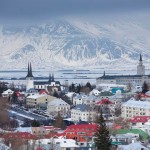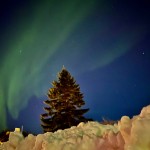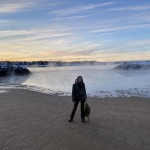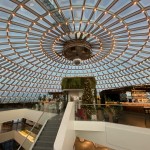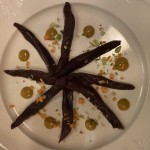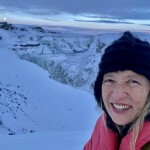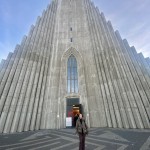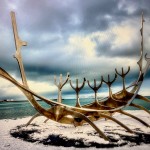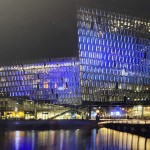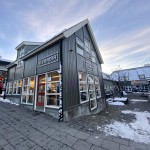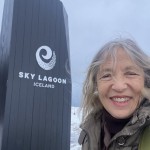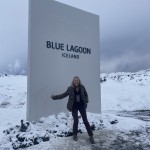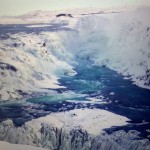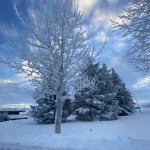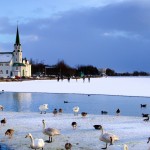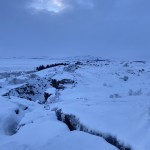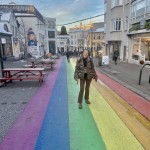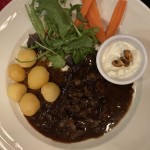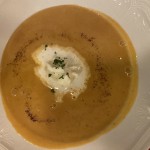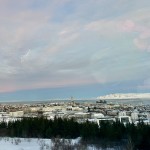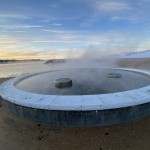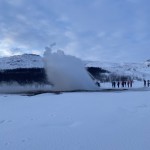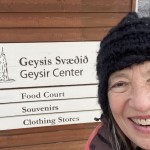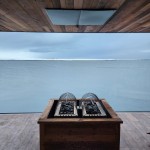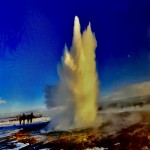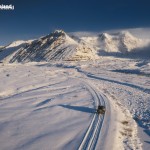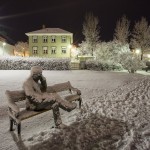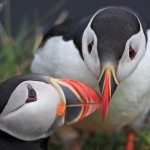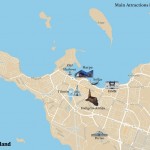Going to Iceland in winter means allowing nature to surprise you. The name says it all, land of ice, and this is already enough of a suggestion to be enraptured by the beauty of this land.
- icelands-capital-city-reykjavik-photo-by-tim-graham-getty-images-960×0
- A due passi dalla capitale di notte
From Keflavik airport it takes about 40 minutes to get to the capital Reykjavik, a “pocket” town compared to the largest European ones, but which is home to a large part of the island’s population (ie 122,000 inhabitants, while the entire nation has approximately 372,000 inhabitants). During the journey, you cross a landscape made of extinguished lava, lit fumaroles, slag, black rocks and evident contrasts that stand out on board the tumultuous waters of the North Atlantic Ocean (we are between Greenland and Great Britain).
- La spiaggia nera di Reykjavik
- Il soffitto del Caffè di Perlan in Reykjavik
This is the northernmost capital in the world and its downtown is really nice because Reykjavik has the brightly colored wooden houses mixed with some futuristic houses. Walking even without a map you will meet the Harpa cultural center with its spectacular glass architectural style that constantly changes shades and the Art Museum with the three sites located around the city that tell both modern and contemporary art.
And then, the magical encounter with the Hallgrímskirkja church made of concrete to recall the basaltic columns typical of the island.
- Il puffin impiattato
- Alle spalle la cascata di Gullfoss
Immediately after, the shopping streets of Laugavegur and Skólavördustigure and a walk along the bay to discover the port and Perlan, from whose high terrace you can enjoy a 360-degree view of Reykjavik and the mountains that frame it.
To shelter from the cold you can visit the strange Babalú café where you can indulge yourself with board games, or the original Forno Baka Baka where you can taste the ever-present Kleina (one of the traditional sweets). And, for those who are curious, in the restaurants you can taste dishes of the ancient Icelandic cuisine, including the recipes of whale meat or puffin; among these the restaurants that I will not forget are the Þrír frakkar and the Jómfrúin, because each of the ingredients it was really very fresh and well cared for in the presentation.
- Hallgrímskirkja
- The Sun Voyager
Thanks to the atmosphere of a capital at the end of the world, you will experience a pleasant city during the day, but also very lively at night, especially when viewed from above after dark because there is never a shortage of fireworks (on the night of New Year’s it seems there were even 600 tons of fires that lit up the coast).
Just visit a small portion to understand why Iceland is continually visited by millions of travellers. A lucky land. The country makes great use of all that energy just below the surface. Geothermal energy meets the needs of almost 90% of the nation’s hot water and heating requirements.
- Harpa di notte
- Forno Baka Baka
And in this season it is a land in which to admire the colors of cold and heat. The crystals of the glaciers, the snow on the roads, the sky with its Aurora Borealis, the fire of the volcanoes (you always perceive), the heat of the geysers, the steam of the fumaroles, the black beaches and “its lagoons” transformed into a tourist business. A continuous contrast of emotions.
And it is also a land of water, not only for its majestic waterfalls (spectacular one at Gullfoss), but above all for its seas rich in fish, crustaceans and whales.
- Davanti alla Sky Lagoon praticamente in città
- Davanti alla Blue Lagoon (vicino all’aeroporto)
And finally, it will give you that crazy feeling of clean breathing. The air of Iceland smells good and allows the colors to be bright and vivid. And it will be perfect even if the colors change every minute to remind everyone that nature is very much alive. And it will still be perfect even if you find bad weather, just wait a few hours and you will see the sky change before your eyes. A magical sky as all of this large island certainly is, even in winter.
ITALIANO: Andare in Islanda d’inverno significa permettere alla natura di sorprenderti. Lo dice il nome, terra del ghiaccio, e già questa è una suggestione sufficiente ad essere rapiti dalla bellezza di questa terra.
- Le bellezze che si incontrano passeggiando
- Che natura!
Dall’aeroporto di Keflavik servono circa 40 minuti per arrivare alla capitale Reykjavik, una cittadina “tascabile” rispetto alle più grandi europee, ma che ospita buona parte della popolazione dell’isola (ovvero 122.000 abitanti, mentre l’intera nazione ha all’incirca 372.000 abitanti).
Durante il tragitto si attraversa un paesaggio fatto di lava spenta, fumarole accese, scorie, rocce nere ed evidenti contrasti che spiccano a bordo delle tumultuose acque dell’Oceano Atlantico settentrionale (siamo tra la Groenlandia e la Gran Bretagna).
- Sul lago cittadino Tjörnin ghiacciato assieme ai cigni (foto di Stefano Tiozzo)
- Il tipico dolce Kleina
Questa è la capitale più settentrionale del mondo e il suo centro è davvero carino perché Reykjavik ha le case in legno dai colori vivaci che si mescolano ad alcune case futuristiche. Camminando anche senza mappa incontrerete il centro culturale Harpa con il suo spettacolare stile architettonico di vetro che cambia continuamente sfumature e il Museo d’Arte con i tre siti dislocati per la città che raccontano sia l’arte moderna e sia quella contemporanea.
E poi, il magico incontro con la chiesa Hallgrímskirkja fatta di cemento per richiamare le colonne basaltiche tipiche dell’isola.
Subito dopo, le vie dello shopping di Laugavegur e Skólavördustigure e una passeggiata lungo la baia alla scoperta del porto e di Perlan, dalla cui terrazza alta godere della vista a 360 gradi su Reykjavik e sulle montagne che la incorniciano.
- Bridge Between Continents, si passeggia in mezzo alle due placche tettoniche tra l’Europa e l’America
- Nel tratto di strada del Gay Pride
Per ripararvi dal freddo potete visitare lo strano caffè Babalú dove sbizzarrirvi con i giochi da tavolo, oppure l’originale Forno Baka Baka dove gustare l’immancabile Kleina (uno dei dolci tradizionali). E, per chi è curioso, nei ristoranti si possono assaggiare piatti dell’antica cucina islandese comprese le ricette di carne di balena o di puffin, tra questi i ristoranti che non dimenticherò sono il Þrír frakkar e il Jómfrúin, perché ogni ingrediente sperimentato era davvero molto fresco e curato nella presentazione.
Grazie all’atmosfera da capitale alla fine del mondo, vivrete una città piacevole di giorno, ma anche molto vivace di notte, soprattutto vedendola dall’alto dopo l’imbrunire perché non mancano mai i fuochi d’artificio (durante la notte di Capodanno pare siano stati addirittura 600 le tonnellate di fuochi che hanno illuminato la costa).
- Balena in umido
- Zuppa di Hallibut
Basta visitarne una piccola porzione per capire come mai l’Islanda sia continuamente meta di milioni di viaggiatori. Una terra fortunata. Il paese fa un grande uso di tutta quell’energia appena sotto la superficie. L’energia geotermica copre quasi il 90% del fabbisogno nazionale di acqua calda e riscaldamento.
E in questa stagione è una terra in cui ammirare i colori del freddo e del caldo. I cristalli dei ghiacciai, la neve sulle strade, il cielo con le sue Aurore Boreali, il fuoco dei vulcani (si percepisce ci sia), il calore dei geyser, il vapore delle fumarole, le spiagge nere e “le sue lagune” trasformate in business turistico. Un continuo contrasto di emozioni.
Ed è anche una terra di acqua, non solo per le sue maestose cascate (da vedere soprattutto quella spettacolare di Gullfoss), ma soprattutto per i suoi mari ricchi di pesci, crostacei e balene.
- Da Perlan si ammira la città
- Appoggiata alla infinita pool della Sky Lagoon
E infine, vi regalerà quella sensazione pazzesca di respirare pulito. L’aria dell’Islanda profuma di buono e permette ai colori di essere luminosi e vividi. E sarà perfetto anche se i colori cambiano ogni minuto a ricordare a tutti che la natura è quanto mai viva. E sarà comunque perfetto anche se troverete brutto tempo, sarà sufficiente attendere qualche ora e vedrete il cielo cambiare sotto i vostri occhi. Un cielo magico come lo è certamente tutta questa grande isola, anche d’inverno.
ESPAÑOL: Ir a Islandia en invierno significa dejarse sorprender por la naturaleza. El nombre lo dice todo, tierra de hielo, y esto ya es suficiente sugerencia para dejarse embelesar por la belleza de esta tierra.
- La geotermia è ovunque
- All’ingresso della grotta della Sky Lagoon
Desde el aeropuerto de Keflavik se tarda unos 40 minutos en llegar a la capital Reykjavik, una ciudad de “bolsillo” en comparación con las más grandes de Europa, pero que alberga una gran parte de la población de la isla (es decir, 122.000 habitantes, mientras que toda la nación tiene aproximadamente 372.000 habitantes).
Durante el trayecto se atraviesa un paisaje hecho de lava extinguida, fumarolas encendidas, escorias, rocas negras y evidentes contrastes que se destacan a bordo de las tumultuosas aguas del Océano Atlántico Norte (estamos entre Groenlandia y Gran Bretaña).
- Gli “spruzzi” del Geysir di Blaskogabyggo
- Al centro Geysir di Blaskogabyggo, il più visitato di Islanda
Esta es la capital más septentrional del mundo y su centro es realmente agradable porque Reykjavik tiene casas de madera de colores brillantes mezcladas con algunas casas futuristas. Caminando incluso sin un mapa, se encontrará con el centro cultural Harpa con su espectacular estilo arquitectónico de vidrio que cambia constantemente de tonos y el Museo de Arte con los tres sitios ubicados alrededor de la ciudad que cuentan tanto el arte moderno como el contemporáneo.
Y luego, el encuentro mágico con la iglesia Hallgrímskirkja hecha de hormigón para recordar las columnas basálticas típicas de la isla.
Inmediatamente después, las calles comerciales de Laugavegur y Skólavördustigure y un paseo por la bahía para descubrir el puerto y Perlan, desde cuya alta terraza se puede disfrutar de una vista de 360 grados de Reykjavik y las montañas que la enmarcan.
- Dalla Spa della Sky Lagoon
- Al centro Geysir di Blaskogabyggo all’imbrunire
Para resguardarte del frío puedes visitar el extraño café Babalú donde podrás deleitarte con juegos de mesa, o el original Forno Baka Baka donde podrás degustar la siempre presente Kleina (uno de los dulces tradicionales). Y, para los curiosos, en los restaurantes se pueden degustar platos de la antigua cocina islandesa (incluidas las recetas de carne de ballena o frailecillo), entre estos los restaurantes que no olvidaré son el Þrír frakkar y el Jómfrúin, porque cada de los ingredientes fue realmente muy fresco y bien cuidado en la presentación.
Gracias a la atmósfera de una capital del fin del mundo, experimentarás una ciudad agradable durante el día, pero también muy animada por la noche, especialmente cuando se ve desde arriba después del anochecer porque nunca faltan los fuegos artificiales (en l’Año Nuevo parece que hubo hasta 600 toneladas de hogueras que iluminaron la costa).
- Visitare l’Islanda in inverno con guidetoiceland.is (foto loro)
- Reykjavik in inverno con guidetoiceland.is (foto loro)
Solo visite una pequeña parte para comprender por qué millones de viajeros visitan Islandia continuamente.
Una tierra afortunada. El país hace un gran uso de toda esa energía justo debajo de la superficie. La energía geotérmica satisface las necesidades de casi el 90% de los requisitos de calefacción y agua caliente de la nación.
Y en esta estación es una tierra en la que admirar los colores del frío y el calor. Los cristales de los glaciares, la nieve en los caminos, el cielo con sus auroras boreales, el fuego de los volcanes (siempre se percibe), el calor de los géiseres, el vapor de las fumarolas, las playas negras y “sus lagunas” transformadas en un negocio turístico. Un continuo contraste de emociones.
Y es también tierra de agua, no sólo por sus majestuosas cascadas (espectacular la de Gullfoss), sino sobre todo por sus mares ricos en peces, crustáceos y ballenas.
- I Pulcinella di mare (foto di Guide to Iceland)
- Reykjavik mappa centro (foto di Guide to Island)
Y por último, te dará esa loca sensación de respiración limpia.
El aire de Islandia huele bien y permite que los colores sean brillantes y vivos. Y será perfecto incluso si los colores cambian cada minuto para recordarles a todos que la naturaleza está muy viva. Y seguirá siendo perfecto incluso si encuentra mal tiempo, solo espere unas horas y verá el cielo cambiar ante sus ojos. Un cielo mágico como lo es todo el de esta gran isla, incluso en invierno.


